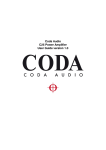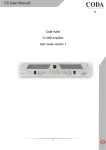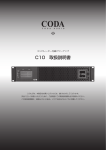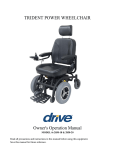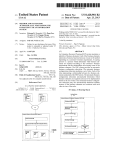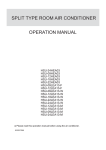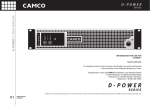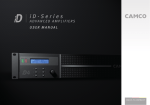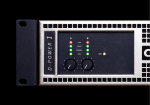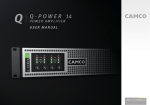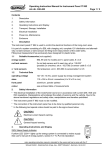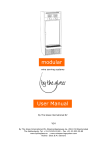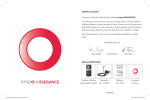Download C10 User Maual
Transcript
C10 User Maual C10 USER MANUAL INFORMATION FOR USE FOR MODELS C10 C10UM_GB_2010-R1_11-2010 The leading version of this brochure is the English one which shall prevail to the exclusion of the national translation on hand. Copyright 2010 by C O DA C10 Please visit our website www.codaoaudio.com for the latest version of this user manual. Please note that the leading version of CODA manuals is always the English one. USER MANUAL v1.0 CODA C10 1 IMPORTANT SAFETY INSTRUCTIONS IMPORTANT SAFETY INSTRUCTIONS 1. General The amplifier may only be used in accordance with the information provided in the user manual. Before and during the usage of the amplifier please ensure that all recommendations, especially the safety recommendations as detailed in the user manual, are adhered to. 5. Power Cord Protection Power supply cords should be routed so that they are not likely to be walked on or pinched by items placed upon them or against them, paying particular attention to cords and plugs and the point where they exit from the amplifier. The C10 amplifier is designed for the amplification of pulsed audio signals. The amplifier should only be connected to speakers with an average impedance as indicated. 6. Heat Do not use this amplifier near any heat sources such as radiators, heat registers, stoves, or other apparatuses that produce heat. 2. User Manual Read the information for use (user manual) and heed all warnings. Keep this user manual in a safe place during the lifetime of the amplifier. The user manual forms an integral part of the amplifier. Reselling the amplifier is only possible if the user manual is available. In case of reselling the amplifier, the reseller has to document any changes made to the amplifier in writing and pass the documentation on to the buyer. 7. Water and Moisture Do not expose this device to rain or moisture. Do not use this amplifier near water (for example swimming pools and fountains). Do not place any objects containing liquids, such as bottles or glasses, on the top of the unit. Do not splash liquids on the unit. IP-20 equipment. There is no protection against splashing water. 3. Environments Use this amplifier only in E1, E2, E3, or E4 environments according to EN55103-2 “Electromagnetic compatibility – Product family standard for audio, video, and audio-visual and entertainment lighting control apparatus for professional use – Part 2: Immunity”. 4. Mounting/Placement Do not place this amplifier on an unstable cart, stand, tripod, bracket, or table. The amplifier may fall causing serious injury and serious damage to the product. Any mounting of the amplifier should follow the manufacturer´s instructions. Only mounting accessory shall be used which is recommended by the manufacturer. 2 USER MANUAL v1.0 CODA C10 8. Ventilation Slots and openings in the cabinet are provided for ventilation to ensure reliable operation of the amplifier and to protect it from overheating. These openings must not be blocked or covered. This amplifier should not be installed unless proper ventilation is provided or manufacturer’s instructions have been adhered to. 9. Interference Of External Objects and/or Liquids with the Appliance Never push objects of any kind into this amplifier through openings as they may touch dangerous voltage points or short-out parts that could result in fire or electric shock. Never spill liquid of any kind on the amplifier. 11. Lightning For additional protection of this amplifier during lightning storms or when it is left unattended and/or unused for long periods of time, unplug it from the wall outlet. This will prevent damage to the amplifier due to lightning and power line surges. Disconnection from the mains power supply can only be achieved by removing the plug from the mains socket and by external disconnecting all poles from the mains. 12. Damages that Require Service Unplug this amplifier from the mains supply and refer to your dealer/distributor or other authorized repair workshop if any of the following situations occur: if liquid has been spilled or objects have fallen into the amplifier if the amplifier has been exposed to rain or moisture if the amplifier has been dropped or damaged in any other way if the power supply cord or plug has been damaged when the amplifier exhibits a distinct change from its normal function or performance in case the amplifier has been used in a dusty environment for quite a period of time IMPORTANT SAFETY INSTRUCTIONS 10. Connections When you connect the amplifier to other equipment, turn off the power and unplug all of the equipment from the supply source. Failure to do so may cause an electric shock and serious personal injury. Read the user manual of the other equipment carefully and follow the instructions when making the connections. 14. Spare Parts When spare parts are required, please ensure that the dealer/distributor only uses spare parts specified by the manufacturer. The use of un authorized spare parts may result in injury and/or damage through fire or electric shock or other electricity-related hazards. 15. Safety Check Upon completion of any service or repairs to this product, ask the dealer/ distributor to perform safety checks to determine that the amplifier works properly. Recommendations on how to carry out the safety test can be found in DIN VDE 0701-1 “Maintenance, Modification and Test of Electronic Appliances“. 16. Cleaning Unplug this amplifier from the wall outlet before cleaning. Do not use liquid or aerosol cleaners. Clean only with dry cloth. 17. Packaging and Shipping When shipping the C10 amplifier, always use the original shipping carton and packing materials. For maximum protection repack the unit as it was originally packed at the factory. 13. Servicing All service and repair work must be carried out by a dealer/distributor authorized by CODA. Do not attempt to service this amplifier yourself. As opening or removing covers may expose you to dangerous voltage or other hazards, the amplifier may only be opened by qualified personnel. Please refer to your dealer/distributor. USER MANUAL v1.0 CODA C10 3 EXPLANATION OF SYMBOLS CAUTION RISK OF ELECTRIC SHOCK DO NOT OPEN CAUTION – HIGH VOLTAGE HAZARDS EXIST WITHIN THIS PRODUCT. REFER ALL SERVICING TO AUTHORIZED PERSONNEL. THE LIGHTNING FLASH WITH ARROW HEAD SYMBOL IS INTENDED TO ALERT THE USER TO THE PRESENCE OF UNINSULATED DANGEROUS VOLTAGE WITHIN THE PRODUCT’S ENCLOSURE. THE EXCLAMATION MARK IS INTENDED TO ALERT THE USER TO IMPORTANT INSTRUCTIONS ALSO FOR MAINTENANCE IN THE LITERATURE ACCOMPANYING THE AMPLIFIER. THE LIGHTNING FLASH WITH ARROW HEAD SYMBOL ALERTS THE USER TO DANGEROUSLY HIGH VOLTAGE AT THE OUTPUT CONNECTORS CAUTION – RISK OF ELECTRIC SHOCK – DO NOT OPEN. WARNING – TO PREVENT FIRE OR SHOCK HAZARD, DO NOT EXPOSE THIS AMPLIFIER TO RAIN OR MOISTURE. THE AMPLIFIER MAY ONLY BE CONNECTED TO A SOCKET WITH A PROTECTIVE EARTH CONDUCTOR. 4 USER MANUAL v1.0 CODA C10 EC DECLARATION OF CONFORMITY EC Declaration Of Conformity In Accordance To EC Directives: electromagnetic compatibility (Council Directive 89/336/EEC, as amended by Directives 92/31/EEC and 93/68/EEC); low-voltage electrical equipment (Council Directive 73/23/EEC ) Manufacturer´s Name: Coda Audio GmbH Manufacturer´s Address: Boulevard der EU 6 D-30539 Hannover Germany Declares That The Product With The Model Name: C10 Conforms To The Following Standards: EN60065 Safety EN55103-1 Emission EN55103-2 Immunity The operating conditions and application environments presupposed in the information for use (user manual) are to be kept to accordingly. Please Note: The following formulations have been chosen: Coda Audio C10 for the type plate and for the EC declaration of conformity. C10 for the front face of the applience and for the text in the user manual. Hannover, 15.12.2010 Svetlomir Alexandrov USER MANUAL v1.0 CODA C10 5 CONTENTS P. 2 IMPORTANT SAFETY INSTRUCTIONS P. 4 EXPLANATION OF SYMBOLS P. 5 EC DECLARATION OF CONFORMITY P. 6CONTENTS P. 7 1 WELCOME 1.1 Welcome To CODA P. 8 2 THE AMP 2.1 Unpacking 2.2 The Amplifier P. 9 2.3 C10 – The Front 2.4 C10 – The Rear P. 10 2.5 Factory settings 3 INSTALLATION 3.1 Mounting P. 11 3.2 Cooling 3.3 Wiring 3.3.1 Analog Input - XLR Connection 3.3.2 Dual Channel Operation P. 12 3.3.3 SPEAKON Connection P. 13 3.4 Mains supply P. 14 4 OPERATION 4.1 Screen User Interface 4.1.1 Screen User Interface Elements 4.1.2 Handle the Selection Bars P. 15 4.1.3 Hot key Functions 4.2 Power On Sequence P. 16 4.3 Indicators 4.3.1 Input Selection LED 4.3.2 Output Mode LED 4.3.3 Clip LED 4.3.4 Sensor LED 4.3.5 Device Identifier LED 4.3.6 DSP LED 4.3.7 Uman Network Status LED P. 17 4.4 Main Menu P. 17 4.5 Input/Output 4.5.1 Input Selection 6 USER MANUAL v1.0 CODA C10 4.5.2 Output Mode 4.6 Amp Gain and Input Sensitivity 4.7 DSP P. 18 4.8 C10 Applications P. 194.8.1 Use with Sensor controlled Subwoofers 4.8.2 Use without comparator P. 20 4.9 Speaker and sensorcable connection P. 214.9.1 Switching Comparator ON/OFF P. 22 4.10 Power Amp Protection Systems 4.10.1 Clip Limiter 4.10.2 SOA Protection 4.10.3 DC Protection 4.10.4 DC Servo 4.10.5 Overcurrent Protection 4.10.6 Thermal Protection 4.11 Main Protections 4.11.1 Inrush Current Limitation 4.11.2 Mains Over Voltage Detection 4.11.3 Mains Failure Detection P. 23 4.11.4 Fuse Protection 4.12 Main SMPS Protections 4.12.1 Overcurrent Protection 4.12.2 Thermal Protection 4.13 Fans P. 24 4.14 Filter Cleaning P. 25 5 SPECIFICATION P. 27 6 TYPICAL PERFORMANCE DIAGRAMS P. 28 7 WARRANTY INFORMATION 7.1 Summary of Warranty 7.2 Items Excluded from This Warranty 7.3 What CODA Will Do 7.4 How to Obtain Warranty Service 7.5 CODA’s Product Improvement P. 29 8 SERVICE INFORMATION P. 30 9 MAINTENANCE INFORMATION 10 DECOMMISSIONING P. 31 COMPANY INFORMATION P. 32 NOTICES/CHANGES MADE TO THE AMPLIFIER 1 WELCOME 1.1 Welcome To CODA AUDIO Coda Audio – designer and manufacturer of highest quality speaker systems Coda Audio is a leading designer and manufacturer of high quality proaudio loudspeaker systems. Core to our products are a number of unique patented driver technology designs which provide outstanding dynamic results as well as improved precision and reliability over conventional components. To ensure the highest quality and control over our products we have our own manufacturing facility in Europe which produces all of the driver and cabinet components. Further benefits to this approach include substantial reductions in cost and quicker times to market for new products. We have a wide product range offering high quality solutions to satisfy the most discerning and complex professional sound reinforcement applications, ranging from portable to installation to touring. Coda Audio is represented via a global network of experienced and technically qualified international distributors. We believe that the best way to get to know us better is by listening to our loudspeakers because: HEARING IS BELIEVING USER MANUAL v1.0 CODA C10 7 2 THE AMPLIFIER 2.1 Unpacking Please unpack and inspect your new amplifier for any damage that may have occurred during transit. If damage is found, notify the transportation company immediately. Only you as the consignee may initiate a claim for shipping damage. CODA will be happy to cooperate fully as needed. Please save the shipping carton as evidence of damage for the shipper’s inspection. 2.2 The Amplifier The C10 amplifiers offer a power output of: Even if the amplifier has arrived in perfect condition, save all packing materials for any future transport of the unit. using a bipolar class H high efficiency power amplifier output stage. When shipping the C10 amplifier, always use the original shipping carton and packing materials. For maximum protection, repack the unit as it was originally packed at the factory. NOTE:NEVER SHIP THE AMPLIFIER WITHOUT THE ORIGINAL PACKING MATERIALS. 4400 W peak per channel @ 4 Ω (3800 W rms) 4400 W peak per channel @ 2 Ω (4000 W rms) 8800 W peak in Mono Bridge @ 4 Ω (7600 W rms) 8800 W peak in Parallel Mono @ 2 Ω (8000 W rms) The C10 power amplifier is fitted with Dual Voltage Switched Mode Power Supply (SMPS) with automatic voltage selection for 120V / 230 V operation, which significantly reduces the weight and size (only 2U) of the amplifier. Using SMPS, the seamlessly regulated symmetrical supply voltages of the power amplifier are more stable and efficient than the power supplies used in conventional amplifiers. The C10 also uses a microprocessor for controlling and monitoring the power amp. This has four main advantages over more traditional power amp systems: Reduced Distortion Improved Noise Characteristics Integrated Remote Control Indication of Protection or Failures The C10 has been designed as an intelligent and powerful amplifier for performing specialised tasks within a complex audio system. Users can adapt the power amp to meet their specific audio requirements before use. The display mounted on the front of the C10 amplifier allow the different functions to be accessed. Since there are a lot of parameters available, it is important that users should familiarize themselves thoroughly with the entire range of settings and programmable features before using the power amp. If you have any questions regarding features and/or functions of your C10 amplifier, CODA will be pleased to provide you with further information. Alternatively, contact your dealer or distributor. 8 USER MANUAL v1.0 CODA C10 1 2 2 THE AMPLIFIER 3-11 12 2 2 2.3 C10 - The Front 1 Display 2 Touch Controls 3 Input Selection LED 4 Output Mode LED 5 Clip LED Channel A 6 Signal LED Channel A 7 Device Indicator LED 8 9 10 11 12 13 13 Clip LED Channel B Signal LED Channel B DSP LED Uman Network Status LED Cooling Air Inlet Vents Removable Air Filter System 2.4 C10 - The Rear 14 AC Power Connector 15 SPEAKON Connectors 16 Cooling Air Outlet Vents 17 Sense Connector 18 XLR - Line Links 19 20 21 22 22 21 XLR - Line Inputs Uman Network Connectors Uman Network Link LED Ethernet Connector for remote access 20 CAMCO PRODUKTIONSUND VERTRIEBS-GMBH FISCHPICKE 5 D-57482 WENDEN GERMANY 14 15 16 17 18 19 USER MANUAL v1.0 CODA C10 9 7,5 mm 10,5 mm 465,0 mm 483,0 mm 10 USER MANUAL v1.0 CODA C10 440,5 mm 442,0 mm 452,0 mm 88,1 mm Amplifier is switched Off Both channels active Analog 0 dB both channels On Dual Channel 32 dB 192.168.1.1 255.255.255.0 192.168.1.1 Off 75% Unlocked Off 76,2 mm Power Status Mute Input Selection Level Attenuator Clip Limiter Output Mode AmpGain IP Settings IP Mask IP Gateway DSP Display Brightness Lock Device Comparator 3.1 Mounting Use four screws and washers when mounting the amplifier to the front rack rails. For mobile use, the amplifier should also be secured using the 19” mounting elements on the rear panel. 424,5 mm 2 THE AMPLIFIER / 3 INSTALLATION 2.5 Factory settings C10 amplifiers are delivered with the following factory settings 3.3 Wiring 3.3.1 Analog Input - XLR Connection XLR: Pin 1 = Ground (or lifted via 15 Ω resistor) Pin 2 = Hot (in-phase) Pin 3 = Cold (out of phase) 3 INSTALLATION 3.2 Cooling Under normal operation of the power amp, overheating should never be a problem. The air is taken in from the front and out through the back. It is of course essential that while the power amp is running, air is able to circulate around it freely. The efficiency of the cooling will depend on both the immediate environment (e.g. an enclosed rack, direct sunlight) and that the front filter is clogged. If the amp is installed in a case, the open area at the back of the case must be at least 140 cm². This area should be in line with the amp. If this cannot be achieved, a forced ventilation system has to be used. 3.3.2 Dual Channel Operation Two fully independent amplifier channels (normal operating mode). C10 A (L) Z ≥ *Zmin B (R) Z ≥ *Zmin Always use symmetrically (balanced) shielded cable to connect the amplifier. LINK B 2 1 3 To Channel B LINK A 2 1 3 Input Channel B 1 2 3 Input Channel A 1 2 3 To Channel A USER MANUAL v1.0 CODA C10 11 3 INSTALLATION 3.3.3 SPEAKON Connection Both SPEAKON connectors are connected to channel A and channel B outputs. The pin configuration of the SPEAKON connectors is as follows: Upper SPEAKON: Pin 1+ Pin 1- Pin 2+ Pin 2- Channel A signal Channel A ground Channel B signal Channel B ground Bottom SPEAKON: Pin 1+ Pin 1- Pin 2+ Pin 2- Channel B signal Channel B ground Channel A signal Channel A ground Input Channel A Upper SPEAKON Input Channel B Bottom SPEAKON 12 USER MANUAL v1.0 CODA C10 Wiring to these terminals requires installation by an instructed person or the use of ready-made leads or cords. Custom wiring should only be carried out by qualified personnel. To prevent electric shock, do not operate the amplifier with any of the conductor portion of the speaker wire exposed. NOTE: For reasons of safety and performance do only use high-quality fully insulated speaker cables of stranded copper wire. Use the largest wire size that is economically and physically practical. Make sure that the cables are not longer than necessary. IMPORTANT: When connecting speaker cabinets in parallel, always use all the contacts in both SPEAKON connectors. If not, this may cause permanent damage to the connectors and considerably reduce performance. 3 INSTALLATION WARNING! SPEAKON connectors marked with the lightning flashes indicate high voltages that are potentially life threatening. 3.4 Mains supply When mounting or connecting the amp, always disconnect it from mains. Only connect the C10 amplifier to an appropriate AC circuit and outlet in accordance with the requirements indicated in the second line on the rating plate. ������ ������ CODA Audio C10 120/230 V ~ 50/60 Hz 2100 W � �� � �� � ������ 4400 W / 2 Ω ��� ����� xxxxx ���� �� ������� Exemplary rating plates for a mains supply of 120/230 V AC 50/60 Hz. Power Supply Data: Voltage C10 120/230 V Mains Frequency Current Power Consumption 50/60 Hz 30/15 A 2100 W NOTE: Even under normal conditions the mains current can reach levels up to 20 A (230 V), and 40 A (120 V), respectively; this could cause lamps to flicker if connected to the same mains as the amp. The impedance of the AC circuit should be less than 0,157 Ω to avoid flicker according to EN61000-3-11 “Electromagnetic compatibility – Part 311: Limits – Limitation of voltage changes, voltage fluctuations, and flicker in the public low-voltage supply systems – Equipment with rated current ≤ 75 A and subject to conditional connection”. If in any doubt, consult your local power provider. Never attempt to measure this impedance level with your Ohmmeter. This may damage your meter and expose you to the risk of electric shock! USER MANUAL v1.0 CODA C10 13 4 OPERATION 4.1 Screen User Interface Due to the advanced approach with the absence of any control knobs or switches, control of all parameters is done via the screen user interface. 4.1.1 Screen User Interface Elements The screen user interface consists of four buttons and two selection bars. 1 6 Vertical Selection Bar (VSB) - scrolls through menu items 4.1.2 Handle the Selection Bars 2 3 6 4 5 -Tip the VSB at the upper half to scroll upwards. -Tip the VSB at the lower half to scroll downwards. 1 MENU button ( ) - touch to leave the current sreen without changes - Hot key: touch and hold (≈2 s) to navigate to the Signal Monitor 2 ENTER button ( ) - navigate to the selected menu item, confirm changes 3 A button ( ) - select channel A 4 B button ( ) - select channel B 5 Horizontal Selection Bar (HSB) - increase/decrease values 14 USER MANUAL v1.0 CODA C10 -Tip the HSB at the left half to decrease values. -Tip the HSB at the right half to increase values. 4 OPERATION 4.1.3 Hot key Functions The Hot key Functions give you a quick access to important setting screens. The Power Hot key is accessible from all menu levels and screens. 4.2 Power On-Sequence As soon as the C10 amplifer is connected to the mains power supply, it will start the Power On-Sequence. The display will show the C10 logo followed by the Power On-Screen. Power Off Hot key: Touch and hold MENU and ENTER simultaneously (≈3 s). Power Off screen will be displayed. Touching again MENU and ENTER simultaneously will start Power Off-Sequence. Level Attenuator Hot key (from monitor screens 3.1-3.4): Touching the HSB opens the Level Attenuator Screen for a quick access to level adjustments. After adjustment you can step back to the previous screen by touching the MENU button. Mute Hot key (from monitor screens 3.2-3.4): Touching button A or button B let you directly jump to the Signal Monitor. Here you can mute/unmute each channel directly by touching button A or button B again. After adjustment you can step back to the previous screen by touching the MENU button. Signal Monitor Hot key Touch and hold MENU (≈3 s) let you directly jump to the Signal Monitor. You can step back to the previous screen by touching the MENU button. This is the screen used to switch the amplifier on/off. Please touch MENU and ENTER simultaneously to switch on the amplifier or touch any of the touch-sensitive elements to activate the display backlight. NOTE: Turning the Amplifier off does NOT disconnect the amplifier from mains. The switch initiates start-up by activating the current limiting function. As soon as the power amplifier is connected to the mains power supply, a voltage is supplied to both the line-filter and the fused input of the controllable rectifier. Disconnecting the amplifier from the main power supply can only be achieved by physically separating the amplifier from the mains by pulling the mains plug. The mains plug therefore has to be freely accessible. Disconnect the mains plug from the mains during a lightning storm or when the amplifier remains unused or unsupervised for a prolonged period of time. Alternatively, you can disconnect the amplifier from the mains via an external all-pole disconnection. If a power cut occurs while the amplifier is switched on, it will restart automatically once the power supply has been restored. All settings prior to the loss of power will be maintained. USER MANUAL v1.0 CODA C10 15 4 OPERATION 4.3 Indicators 4.3.3 Clip LED (Channel A/Channel B) This LED indicates an overloading of the amplifier when the power output level is too high. Input Selection LED Output Mode LED Clip LED Channel A Sensor LED Channel A Device Identifier LED Clip LED Channel B Sensor LED Channel B DSP LED Uman LED 4.3.4 Sensor LED (Channel A/Channel B) The green Sensor LED is illuminated when the voltage level at the output reaches approx. 4 V; this corresponds to a power of approx. 4 W over a 4 Ω resistor. LED is off - Comparator not active LED lit Orange - Comparator active LED green (flashinng) - Sensor and Comparator are oparating LED Red - Sensor/Comparator fault. Check Sensorcable cconnections. 4.3.1 Input Selection LED The status of the bi-coloured (green/red) LED changes between off, green, and red depending on the selected Input Selection (see 4.5.1). LED is off - Analog Inputs active LED lit green - Digital (Uman) inputs active LED lit red - If Digital with Analog Fallback is selected, the red Input Mode LED indicates that one of the digital inputs have failed and will be replaced by analog backup signal. 4.3.2 Output Mode LED The status of the bi-coloured (green/orange) LED changes between off, green, and orange depending on the selected Output Mode (see 3.3 & 4.5.2). LED is off LED lit green LED lit orange - - - Dual Channel Operation Mono Bridge Operation Parallel Mono Operation 1 - CH Amplifier INPUT Digital INPUT STAGE INPUT Analog Feedback Comparator Speaker +32 dB Level detect Control Unit 4.3.5 Device Identifier LED This white coloured LED helps you to identify an amplifier in a large Uman network. By activating the Identify Device function in Uman software, the Device Identifer LED of the corresponding amplifier will shine. 4.3.6 DSP LED The green DSP LED is illuminated when the optional DSP-Board is installed and routed into the signal path. 4.3.7 Uman LED The green Uman LED is illuminated when the amplifier is connected to a Uman network. 16 USER MANUAL v1.0 CODA C10 All settings important for operation of the amplifier are accessible in the Settings menu. Information about operating state of the amplifier like Temperature, Output Signal, Configuration Overview, and Network Overview are accessible in the Monitor menu. Adjustments for display brightness and contrast will be done in menu Display. Digital with Analog fallback For normal operation the input signals are taken from the Uman Digital Audio Network Interface. In case of a disconnection or failure of the Digital Audio Network the fallback mode automatically switches over to the analog inputs and gives you an extra portion of redundancy. 4.5.2 Output Mode There are three different Output Modes available: Dual Channel Operation Mono Bridge Operation Parallel Mono Operation A temporary lock of the touch-sensitive elements to prevent unintentional changes is accessible through the Lock Device menu. For more information about Output Modes please see section 3.3. The serial number and current firmware version of your C10 are displayed in the System Info. 4.6 Amp Gain and Input Sensitivity The C10 amplifier has a 32 dB voltage gain sensitivity setting. Please consult the C10 Navigation Guide for details about the menu. You can always find the current C10 Navigation Guide on our website codaaudio.net. The table shows input sensitivity per channel for a given gain and load. 4.5 Input/Output 4.5.1 Input Selection Due to the fact that the C10 amplifier has a Uman Digital Audio Network Interface which is built-in and ready to use, there are three different Input selections possible: C10 Analog In this mode analog signals connected to the XLR Input connectors at the back of the amplifier will be used as input signal. Digital With the digital setting input signals are taken from the Uman Digital Audio Network Interface. 4 OPERATION 4.4 Main Menu To switch the amplifier off use the Power menu. Model 32 dB 4330 W @ 2 Ω* 2,35 V 3885 W @ 4 Ω* 3,14 V 2350 W @ 8 Ω* 3,46 V 1250 W @ 16 Ω* 3,56 V 4955 W Peak @ 4 Ω ** 3,58 V * All channels driven, 1 kHz, >1% THD @ 230 VAC ** Peak Power at 4 Ohm, component tolerance dependent (+/-1,25%) Subject to technical alterations without prior notice 4.7 DSP With the optional DSP-Board installed you can route the DSP into the signal chain (DSP On) or bypass the complete DSP section (DSP Off). For more information regarding DSP functionality and Remote Control of the Amplifier please visit www.codaaudio.com. USER MANUAL v1.0 CODA C10 17 4 OPERATION 4.8 Applications AIRLINE LA12 18 USER MANUAL v1.0 CODA C10 AIRLINE LA8 SC8 SC4 SCP SC8 SC4 4 OPERATION 4.8.1 Use with sensor controlled Subwoofers 4.8.2 Use without comparator. AIRLINE LA12, AIRLINE LA8, CUE-Series, etc. SCP Comparator ON The Sensor LED is Orange AIRLINE LA12 AIRLINE LA8 CUE-Series Comparator OFF The Sensor LED is not glowing USER MANUAL v1.0 CODA C10 19 4 OPERATION 4.9 Speaker and Sensorcable connection CAMCO PRODUKTIONSUND VERTRIEBS-GMBH FISCHPICKE 5 D-57482 WENDEN GERMANY 5-Pol XLR Sensor Cable connection 4-Pol Speakon Cable connection 20 USER MANUAL v1.0 CODA C10 4 OPERATION 5.9.1 Switching Comparator ON/OFF 1. Press the MENU ( ) and scroll down by using the Vertical Selection Bar (VSB) to the Menu point 2 Settings. 2. You are now in the Settings Menu. Use the Vertical Selection Bar (VSB) to go to the Menu point 2.14 Comparator. Press the ENTER button ( Press the ENTER button ( ) ) 3. You are now in the Comparator Menu. Press button A ( ) - to switch the Comparator ON/OFF for Channel A Press button B ( ) - to switch the Comparator ON/OFF for Channel B The green Sensor LED is illuminated when the voltage level at the output reaches approx. 4 V; this corresponds to a power of approx. 4 W over a 4 Ω resistor. LED is off - Comparator not active LED lit Orange - Comparator active LED green (flashinng) - Sensor and Comparator are oparating LED Red - Sensor/Comparator fault. Check Sensorcable USER MANUAL v1.0 CODA C10 21 4 OPERATION 4.10 Power Amp Protection Systems 4.10.1 Clip Limiter If the power amp is overdriven, the clip detection circuit triggers the microprocessor. The processor reduces the input signal level by controlling the DCA. The strategy is implemented in software. For sinusoidal input signals the microprocessor limits the input signal in such a way that non-linear distortions of the signal never exceed 1 %. The Clip Limiter can work on each channel independently (except in the two mono-operation modes). To disable the Clip Limiter, use 2.5 Clip Limiter Screen. 4.10.2 SOA Protection To ensure that the power transistors are only used in the Safe Operation Area (SOA), the SOA-protection would mute the corresponding channel. If the power transistors are back in their SOA, the channel is automatically unmuted again. 4.10.3 DC Protection Each output of the power amp is constantly monitored for persistent DC voltage levels. If the 3 V threshold voltage is exceeded at any of the outputs, the corresponding channel will be automatically switched off. The microprocessor performs a sophisticated strategy to locate the cause of the malfunction. DC can be located in the output stage, driver stage, or at the input of the amplifier. Output Stage When a persistent DC voltage is located at an output stage, the main SMPS remains switched off. This will be indicated in the amplifier‘s display. Driver Stage When a DC voltage is located at the driver stage, only the defective channel’s output stage and the DCA are muted. The other channel continues to work. This will be indicated in the amplifier‘s display. Amplifier Input When DC is located at the input stage, only the DCA of the affected channel is muted. The other channel continues to operate normally. If the DC signal at the input vanishes, the microprocessor will unmute the affected channel and the amplifier will work as usual again. This will be shortly indicated in the amplifier‘s display. 22 USER MANUAL v1.0 CODA C10 4.10.4 DC Servo To prevent DC Offset at the speaker output, the C10 amplifiers are fitted with two DC Servos (hence there are no capacitors in the signal path!). 4.10.5 Overcurrent Protection The output stage is permanently monitored for possible current surges. There are two limiting levels of overcurrent depending on output voltage. These limits will be set automatically. This improves reliability without degrading sound quality when driving complex loads. 4.10.6 Thermal Protection The microprocessor uses several sensors on the amplifier‘s heatsinks in order to ascertain temperature data. If the microprocessor detects a temperature of more than 85 °C at the amplifier‘s heat sinks, the input signal on that channel is automatically reduced. If the temperature exceeds 95 °C, the corresponding channel is muted. If the temperature exceeds approx. 110 °C, the main SMPS is switched off as an emergency protection. The thermal protection status of the amplifiers are indicated in the display. 4.11 Mains Protections 4.11.1 Inrush Current Limitation Within 2 seconds of the C10 amplifiers being switched on, the inrush current limiter will increase mains current from nearly zero to nominal value. This value depends on programme material, output level, and speaker loads. 4.11.2 Mains Over Voltage Detection Mains Over Voltage Detection is always operative. When the mains voltage exceeds approx. 265 V (230 V operation), or 134 V (120 V operation) , the amplifier will switch off. When the mains voltage returns to nominal value, a soft start occurs. 4.11.3 Mains Failure Detection Mains Failure Detection is always operative. When the mains supply is interrupted for about 2 mains cycles, the amplifier will switch off. When the mains voltage returns to a normal value, a soft start occurs. 4 OPERATION 4.11.4 Fuse Protection The average mains current can peak temporarily, depending on the load impedance and type of signal, at values several times higher than the nominal value allowed by the fuse protection. Continuous monitoring of the fuse protection status allows the conditions that would trigger the fuse protection to be predicted. In order to avoid shut-down of the amplifier due to current overload, the amplitude of the input signals will be limited. The limitation of the input signal allows the C10 power amplifier to be operated reliably from a mains power supply of 230 V/15 A (120 V/30 A). 4.12 Main SMPS Protections 4.12.1 Overcurrent Protection Main SMPS (Switched Mode Power Supply) transformer current of your C10 amplifier is continuously monitored. If over current occurs, the main SMPS immediately stops working. Should there be an internal failure, this feature prevents other parts being damaged. 4.12.2 Thermal Protection The temperature of the main SMPS transformer of your C10 amplifier is permanently monitored. If the temperature exceeds 85 °C, the main SMPS is switched off. The amplifier‘s display will indicate a main SMPS error in this case. 4.13 Fans The fans mounted in your C10 amplifier operate permanently, but as long as the temperature remains below 40 °C, they run at their slowest speed and can hardly be heard. The highest detected temperature from either channel controls the speed of the fans. Above 40 °C the speed is increased until it reaches its maximum value. USER MANUAL v1.0 CODA C10 23 4 OPERATION 4.14 Filter Cleaning The air intake on the front of your C10 amplifier is fitted with a removable filter system. If the filter becomes clogged, the unit will not cool as efficiently as it should and may result in reduced output levels. WARNING: Turn off the amplifier before removing the front frame! To clean or replace the filter just slightly unscrew the fixing screw with the help of a 2 mm allen key. The screw will be held back by a small plastic spacer on the back of the frame to avoid losing it. Then shift the front frame slightly to the right. Then you should be able to remove the frame from the amplifier completely (pull gently to avoid any bending of the front frame) 1 2 C10 Filter Assembly 1 Foam Filter 2 Front Frame 3 Screw 24 USER MANUAL v1.0 CODA C10 3 Duration limited by fuse / thermal protection for RL<8 Ω in dual channel operation or RL < 16 Ω in mono bridge operation measurement at 2 Ω without preconditioning (EN 60268-3) 1 kHz, THD ≤ 1%, in mono bridge operation Circuitry Signal to Noise-Ratio 20 Hz - 20 kHz, 8 Ω load Power consumption @ 230 V 5 SPECIFICATION Output Power 1 kHz, THD ≤ 1%, in dual channel operation 1250 W @ 16 Ω* 2350 W @ 8 Ω* 3885 W @ 4 Ω* 4330 W @ 2 Ω* 4955 W Peak @ 4 Ω** 4700 W @ 16 Ω* 7770 W @ 8 Ω* 8660 W @ 4 Ω* 9910 W @ 8 Ω Peak** Hybrid Class H >107 dB (unweighted) >110 dB (A-weighted) tba. (both channels driven) * All channels driven, 1 kHz, >1% THD @ 230 VAC ** Peak Power at 4 Ohm, component tolerance dependent (+/-1,25%) Subject to technical alterations without prior notice. USER MANUAL v1.0 CODA C10 25 5 SPECIFICATION Frequency Response 20 Hz - 20 kHz ± 0,15 dB 8 Ω, 1 dB below rated power Input Impedance Input Gain Protection Circuits Limiter Fan LED Indicators Input Connectors Output Connectors Modes of Operation Options THD+N (typical) 22 kΩ balanced 32 dB inrush-current limitation, protection circuits against power on/off transients, temperature monitoring fo transformers and heatsinks, output DC protection, temperature dependent SOA protection, intelligent mains fuse protection clip limiter two temperature dependent speed-controlled axial fans LEDs for Input Selection, Output Mode, Clip, Signal, Device Identify, Sensor, and Uman 3-pin XLR, male and female per channel, pin 2 = hot (inphase) Uman network connectors (In and out) Ethernet Link One 4-pole SPEAKON connector for each output channel (bi-amping possilbe) dual channel, mono bridge and parallel mono Plug-in DSP card available <0,01% 20 Hz - 20 kHz, 8 Ω load, 3 dB below rated power SMPTE (typical) <0,01% 20 Hz - 20 kHz, 8 Ω load, 3 dB below rated power Damping Factor 8 Ω load, 1 kHz and below Dimensions (WxHxD) Net Weight Shipping Dimensions (WxHxD) Shipping Weight >400 483x88,1x452,5 mm / 19x3,5x17,2 inches (19”, 2U) 13 kg / 28,7 lbs 615x135x540 mm (0,045 m3) / 21,3x5,3x24,2 inches 15,6 kg / 34,4 lbs We reserve the right to make technical alterations without prior notice 26 USER MANUAL v1.0 CODA C10 6 TYPICAL PERFORMANCE DIAGRAMS 6 Typical Performance Diagrams tba. USER MANUAL v1.0 CODA C10 27 7 WARRANTY INFORMATION 7.1 Summary of Warranty CODA guarantees the C10 Amplifier to be free from defective material and/or workmanship for a period of six (6) years from the date of sale. When a defect occurs under normal installation and use, CODA will repair the product under this warranty. In this event, please return the amplifier to your dealer/distributor together with a copy of your sales receipt as proof of purchase. 7.4 How to Obtain Warranty Service You must notify your dealer/distributor of your need for warranty service. All components must be shipped in the original packaging. This warranty provides that examination of the returned product must indicate in our judgement a manufacturing defect. 7.2 Items Excluded from This Warranty CODA is not liable for any damage caused by shipping accidents, misuse, abuse, operation with incorrect AC voltage, operation with faulty peripheral equipment, modification or alteration without prior factory approval, service by an unauthorized service center and normal wear and tear. Amplifiers on which the serial number has been removed or defaced are not eligible for warranty service. 7.3 What CODA Will Do CODA (or its appointed agent) undertakes to rectify any defect regardless of the reason for failure (unless excluded from this warrenty), by repair, replacement or refund as it sees fit. 28 USER MANUAL v1.0 CODA C10 7.5 CODA’s Product Improvement CODA reserves the right to improve the technical standard of its products without giving prior notice. If in any doubt, please consult your dealer/distri butor or contact CODA directly for clarification. 8 SERVICE INFORMATION PLEASE ENCLOSE THIS COMPLETED FORM WITH THE AMPLIFIER DO NOT SEND SEPARATELY Owner’s Information Company Name: ���������������������������������������������������������������������� ��������������������������������������������������������������������������������������������� Contact: ���������������������������������������������������������������������������������� Address: �������������������������������������������������������������������������������� ��������������������������������������������������������������������������������������������� ��������������������������������������������������������������������������������������������� ��������������������������������������������������������������������������������������������� Telephone: _ _ _ _ _ _ _ _ _ _ _ _ _ _ _ _ _ _ _ _ _ _ _ _ _ _ _ Facsimile: _ _ _ _ _ _ _ _ _ _ _ _ _ _ _ _ _ _ _ _ _ _ _ _ _ _ _ eMail Address: _ _ _ _ _ _ _ _ _ _ _ _ _ _ _ _ _ _ _ _ _ _ _ _ _ Model: _ _ _ _ _ _ _ _ _ _ _ _ _ _ _ _ _ _ _ _ _ _ _ _ _ _ _ _ Serial Number: _ _ _ _ _ _ _ _ _ _ _ _ _ _ _ _ _ _ _ _ _ _ _ _ _ Purchase Date: _ _ _ _ _ _ _ _ _ _ _ _ _ _ _ _ _ _ _ _ _ _ _ _ _ Nature of problem occurred Please describe the conditions that existed when the problem occured and what attempts were made to correct it: ������������������������������������������� _ _ _ _ _ _ _ _ _ _ _ _ _ _ _ _ _ _ _ _ _ _ _ _ _ _ _ _ _ _ _ _ _ _ _ _ _ _ _ _ _ _ _ _ _ _ _ _ _ _ _ _ _ _ _ _ _ _ _ _ _ _ _ _ _ _ _ _ _ _ _ _ _ _ _ _ _ _ _ _ _ _ _ _ _ _ _ _ _ _ _ _ _ _ _ _ _ _ _ _ _ _ _ _ _ _ _ _ _ _ _ _ _ _ _ _ _ _ _ _ _ _ _ _ _ _ _ _ _ _ _ _ _ _ _ _ _ _ _ _ _ _ _ _ _ _ _ _ _ _ _ _ _ _ _ _ _ _ _ _ _ _ _ _ _ _ _ _ _ _ _ _ _ _ _ _ _ _ _ _ _ _ _ _ _ _ _ _ _ _ _ _ _ _ _ _ _ _ _ _ _ _ _ _ _ _ _ _ _ _ _ _ _ _ _ _ _ _ _ _ _ _ _ _ _ _ _ _ _ _ _ _ _ _ _ _ _ _ _ _ _ _ _ _ _ _ _ _ _ _ _ _ _ _ _ _ _ _ _ _ _ _ _ _ _ _ _ _ _ _ _ _ _ _ _ _ _ _ _ _ _ _ _ _ _ _ _ _ _ _ _ _ _ _ _ _ _ _ _ _ _ _ _ _ _ _ _ _ _ _ _ _ _ _ _ _ _ _ _ _ _ _ _ _ _ _ _ _ _ _ _ _ _ _ _ _ _ _ _ _ _ _ _ _ _ _ _ _ _ _ _ _ _ _ _ _ _ _ _ _ _ _ _ _ _ _ _ _ _ _ _ _ _ _ _ _ _ _ _ _ _ _ _ _ _ _ _ _ _ _ _ _ _ _ _ _ _ _ _ _ _ _ _ Expired Warranty If the warranty has expired, payment will be: o o Cash/Cheque o MasterCard VISA Shipping Address To transport the amplifier, the original packing materials must be used. Please return the amplifier to the following address or your nearest CODA appointed distributor. Other equipment in your system: _ _ _ _ _ _ _ _ _ _ _ _ _ _ _ _ _ _ _ _ _ _ _ _ _ _ _ _ _ _ _ _ _ _ _ _ _ _ _ _ _ _ _ _ _ _ _ _ _ _ _ _ _ _ _ _ _ _ _ _ _ _ _ _ _ _ _ _ _ _ _ _ _ _ _ _ _ _ _ _ _ _ _ _ _ _ _ _ _ _ _ _ _ _ _ _ _ _ _ _ _ _ _ _ _ _ _ _ _ _ _ _ _ _ _ _ _ _ _ _ _ _ _ _ _ _ _ _ _ _ _ _ _ _ _ _ _ _ _ _ _ _ _ _ _ _ _ _ _ _ _ _ _ _ _ _ _ _ _ _ _ _ _ _ _ _ _ _ _ _ _ _ _ Our web site: www.codaaudio.com provides a complete list of CODA dealers/distributors. USER MANUAL v1.0 CODA C10 29 9 MAINTENANCE INFORMATION/10 DECOMISSIONING 9 Maintenance Information Cleaning and servicing the inside of the amplifier must never be carried out by unqualified personnel. The amplifier must never be opened by unqualified personnel. Cleaning and servicing work on the inside of the amplifier must only be carried out by qualified personnel. Qualified personnel is defined as a person who has gained specialised relevant knowledge of electronic engineering through education, training, and experience, and who has sufficient knowledge of all relevant governmental work safety regulations to be in a position to judge the safe functioning of power amplifiers based on technical rules according to IEC 60065 (IEC 60065 (DIN EN 60065) “Safety Requirements for Audio, Video or simlar Electronic Appliances”). In order to guarantee the safe functioning of the amplifier, it has to be checked regularly, depending on its application but at least once a year, by a properly qualified person. Advice on how to carry out these checks can be found in DIN VDE 0702-1 “Safety Checks for Electronic Appliances” . An amplifier that is considered to be unsafe must be labelled accordingly and stored in a safe place to prevent this amplifier being used mistakenly. 30 USER MANUAL v1.0 CODA C10 10 Decommissioning During the decommissioning process of the amplifier, all legally prescribed rules and procedures must be adhered to. COMPANY INFORMATION Mailing Address: Coda Audio GmbH Boulevard der EU 6 D-30539 Hannover Germany Telephone: +49 (0) 511 866 558 88 Facsimile: +49 (0) 511 866 558 87 Internet: www.codaaudio.com Email: [email protected] USER MANUAL v1.0 CODA C10 31 Coda Audio GmbH Boulevard der EU 6 30539 Hannover Germany www.codaaudio.com NOTICES/CHANGES MADE TO THE AMPLIFIER Changes Made To The Amplifier NOTE / IMPORTANT: Please consider that any changes made to the amplifier have to be documentated in writing and passed on to the buyer in the event of resale! �������������������������������������������������������������������������������������������� _ _ _ _ _ _ _ _ _ _ _ _ _ _ _ _ _ _ _ _ _ _ _ _ _ _ _ _ _ _ _ _ _ _ _ _ _ _ _ _ _ _ _ _ _ _ _ _ _ _ _ _ _ _ _ _ _ _ _ _ _ _ _ _ _ _ _ _ _ _ _ _ _ _ _ _ _ _ _ _ _ _ _ _ _ _ _ _ _ _ _ _ _ _ _ _ _ _ _ _ _ _ _ _ _ _ _ _ _ _ _ _ _ _ _ _ _ _ _ _ _ _ _ _ _ _ _ _ _ _ _ _ _ _ _ _ _ _ _ _ _ _ _ _ _ _ _ _ _ _ _ _ _ _ _ _ _ _ _ _ _ _ _ _ _ _ _ _ _ _ _ _ _ _ _ _ _ _ _ _ _ _ _ _ _ _ _ _ _ _ _ _ _ _ _ _ _ _ _ _ _ _ _ _ _ _ _ _ _ _ _ _ _ _ _ _ _ _ _ _ _ _ _ _ _ _ _ _ _ _ _ _ _ _ _ _ _ _ _ _ _ _ _ _ _ _ _ _ _ _ _ _ _ _ _ _ _ _ _ _ _ _ _ _ _ _ _ _ _ _ _ _ _ _ _ _ _ _ _ _ _ _ _ _ _ _ _ _ _ _ _ _ _ _ _ _ _ _ _ _ _ _ _ _ _ _ _ _ _ _ _ _ _ _ _ _ _ _ _ _ _ _ _ _ _ _ _ _ _ _ _ _ _ _ _ _ _ _ _ _ _ _ _ _ _ _ _ _ _ _ _ _ _ _ _ _ _ _ _ _ _ _ _ _ _ _ _ _ _ _ _ _ _ _ _ _ _ _ _ _ _ _ _ _ _ _ _ _ _ _ _ _ _ _ _ _ _ _ _ _ _ _ _ _ _ _ _ _ _ _ _ _ _ _ _ _ _ _ _ _ _ _ _ _ _ _ _ _ _ _ _ _ _ _ _ _ _ _ _ _ _ _ _ _ _ _ _ _ _ _ _ _ _ _ _ _ _ _ _ _ _ _ _ _ _ _ _ _ _ _ _ _ _ _ _ _ _ _ _ _ _ _ _ _ _ _ _ _ _ _ _ _ _ _ _ _ _ _ _ _ _ _ _ _ _ _ _ _ _ _ _ _ _ _ _ _ _ _ _ _ _ _ _ _ _ _ _ _ _ _ _ _ _ _ _ _ _ _ _ _ _ _ _ _ _ _ _ _ _ _ _ _ _ _ _ _ _ _ _ _ _ _ _ _ _ _ _ _ _ _ _ _ _ _ _ _ _ _ _ _ _ _ _ _ _ _ _ _ _ _ _ _ _ _ _ _ _ _ _ _ _ _ _ _ _ _ _ _ _ _ _ _ _ _ _ _ _ _ _ _ _ _ _ _ _ _ _ _ _ _ _ _ _ _ _ _ _ _ _ _ _ _ _ _ _ _ _ _ _ _ _ _ _ _ _ _ _ _ _ _ _ _ _ _ _ _ _ _ _ _ _ _ _ _ _ _ _ _ _ _ _ _ _ _ _ _ _ _ _ _ _ _ _ _ _ _ _ _ _ _ _ _ _ _ _ _ _ _ _ _ _ _ _ _ _ _ _ _ _ _ _ _ _ _ _ _ _ _ _ _ _ _ _ _ _ _ _ _ _ _ _ _ _ _ _ _ _ _ _ _ _ _ _ _ _ _ _ _ _ _ _ _ _ _ _ _ _ _ _ _ _ _ _ _ _ _ _ _ _ _ _ _ _ _ _ _ _ _ _ _ _ _ _ _ _ _ _ _ _ _ _ _ _ _ _ _ _ _ _ _ _ _ _ _ _ _ _ _ _ _ _ _ _ _ _ _ _ _ _ _ _ _ _ _ _ _ _ _ _ _ _ _ _ _ _ _ _ _ _ _ _ _ _ _ _ _ _ _ _ _ _ _ _ _ _ _ _ _ _ _ _ _ _ _ _ _ _ _ _ _ _ _ _ _ _ _ _ _ _ _ _ _ _ _ _ _ _ _ _ _ _ _ _ _ _ _ _ _ _ _ _ _ _ _ _ _ _ _ _ _ _ _ _ _ _ _ _ _ _ _ _ _ _ _ _ _ _ _ _ _ _ _ _ _ _ _ _ _ _ _ _ _ _ _ _ _ _ _ _ _ _ _ _ _ _ _ _ _ _ _ _ _ _ _ _ _ _ _ _ _ _ _ _ _ _ _ _ _ _ _ _ _ 32 USER MANUAL v1.0 CODA C10 _ _ _ _ _ _ _ _ _ _ _ _ _ _ _ _ _ _ _ _ _ _ _ _ _ _ _ _ _ _ _ _ _ _ _ _ _ _ _ _ _ _ _ _ _ _ _ _ _ _ _ _ _ _ _ _ _ _ _ _ _ _ _ _ _ _ _ _ _ _ _ _ _ _ _ _ _ _ _ _ _ _ _ _ _ _ _ _ _ _ _ _ _ _ _ _ _ _ _ _ _ _ _ _ _ _ _ _ _ _ _ _ _ _ _ _ _ _ _ _ _ _ _ _ _ _ _ _ _ _ _ _ _ _ _ _ _ _ _ _ _ _ _ _ _ _ _ _ _ _ _ _ _ _ _ _ _ _ _ _ _ _ _ _ _ _ _ _ _ _ _ _ _ _ _ _ _ _ _ _ _ _ _ _ _ _ _ _ _ _ _ _ _ _ _ _ _ _ _ _ _ _ _ _ _ _ _ _ _ _ _ _ _ _ _ _ _ _ _ _ _ _ _ _ _ _ _ _ _ _ _ _ _ _ _ _ _ _ _ _ _ _ _ _ _ _ _ _ _ _ _ _ _ _ _ _ _ _ _ _ _ _ _ _ _ _ _ _ _ _ _ _ _ _ _ _ _ _ _ _ _ _ _ _ _ _ _ _ _ _ _ _ _ _ _ _ _ _ _ _ _ _ _ _ _ _ _ _ _ _ _ _ _ _ _ _ _ _ _ _ _ _ _ _ _ _ _ _ _ _ _ _ _ _ _ _ _ _ _ _ _ _ _ _ _ _ _ _ _ _ _ _ _ _ _ _ _ _ _ _ _ _ _ _ _ _ _ _ _ _ _ _ _ _ _ _ _ _ _ _ _ _ _ _ _ _ _ _ _ _ _ _ _ _ _ _ _ _ _ _ _ _ _ _ _ _ _ _ _ _ _ _ _ _ _ _ _ _ _ _ _ _ _ _ _ _ _ _ _ _ _ _ _ _ _ _ _ _ _ _ _ _ _ _ _ _ _ _ _ _ _ _ _ _ _ _ _ _ _ _ _ _ _ _ _ _ _ _ _ _ _ _ _ _ _ _ _ _ _ _ _ _ _ _ _ _ _ _ _ _ _ _ _ _ _ _ _ _ _ _ _ _ _ _ _ _ _ _ _ _ _ _ _ _ _ _ _ _ _ _ _ _ _ _ _ _ _ _ _ _ _ _ _ _ _ _ _ _ _ _ _ _ _ _ _ _ _ _ _ _ _ _ _ _ _ _ _ _ _ _ _ _ _ _ _ _ _ _ _ _ _ _ _ _ _ _ _ _ _ _ _ _ _ _ _ _ _ _ _ _ _ _ _ _ _ _ _ _ _ _ _ _ _ _ _ _ _ _ _ _ _ _ _ _ _ _ _ _ _ _ _ _ _ _ _ _ _ _ _ _ _ _ _ _ _ _ _ _ _ _ _ _ _ _ _ _ _ _ _ _ _ _ _ _ _ _ _ _ _ _ _ _ _ _ _ _ _ _ _ _ _ _ _ _ _ _ _ _ _ _ _ _ _ _ _ _ _ _ _ _ _ _ _ _ _ _ _ _ _ _ _ _ _ _ _ _ _ _ _ _ _ _ _ _ _ _ _ _ _ _ _ _ _ _ _ _ _ _ _ _ _ _ _ _ _ _ _ _ _ _ _ _ _ _ _ _ _ _ _ _ _ _ _ _ _ _ _ _ _ _ _ _ _ _ _ _ _ _ _ _ _ _ _ _ _ _ _ _ _ _ _ _ _ _ _ _ _ _ _ _ _ _ _ _ _ _ _ _ _ _ _ _ _ _ _ _ _ _ _ _ _ _ _ _ _ _ _ _ _ _ _ _ _ _ _ _ _ _ _ _ _ _ _ _ _ _ _ _ _ _ _ _ _ _ _ _ _ _ _ _ _ _ _ _ _ _ _ _ _ _ _ _ _ _ _ _ _ _ _ _ _ _ _ _ _ _ _ _ _ _ _ _ _ _ _ _ _ _ _ _ _ _ _ _ _ _ _ _ _ _ _ _ _ _ _ _ _ _ _ _ _ _ _ _ _ _ _ _ _ _ _ _ _ _ _ _ _ _ _ _ _ _ _ _ _ _ _ _ _ _ _ _ _ _ _ _ _ _ _ _ _ _ _ _ _ _ _ _ _ _ _ _ _ _ _ _ _ _ _ _ _ _ _ _ _ _ _ _ _ _ _ _ _ _ _ _ _ _ _ _ _ _ _ _ _ _ _ _ _ _ _ _ _ _ _ _ _ _ _ _ _ _ _ _ _ _ _ _ _ _ _ _ _




































